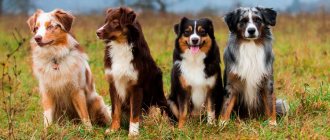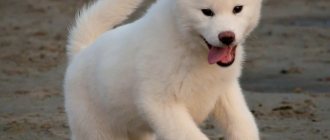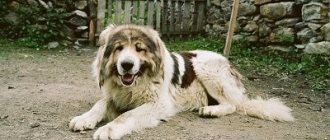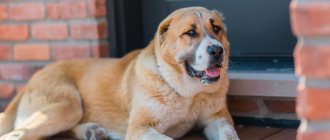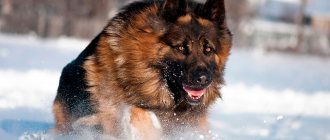Origin of the word shepherd
The Shepherd is a fairly common breed whose name is well known to everyone. But where did the word “shepherd” come from? If you look at the history of the German Shepherd breed in detail, you will understand that it got its name for a reason. In ancient times, sheepskin was the name given to processed sheep skin. Therefore, this word gave the name to individuals who tended flocks of sheep and protected them from wild animals and people who might covet the cattle. By the way, the ancestor of the breed was the Hofowart, which came from crossing an ordinary European dog and an Indian wolf, which is a predatory animal.
Indian wolf
In general, these animals began to be mentioned in historical sources around the 16th century. It was written about them that they are quite powerful and strong dogs with a death grip. It’s not for nothing that their ancestor was a predator.
Description of the breed
If you decide to get yourself a large dog, you must first weigh the pros and cons. First of all, evaluate your capabilities. The German Shepherd, like other large breeds, requires a lot of time and attention. This applies primarily to long walks and workouts.
It wouldn’t hurt to get acquainted with the history of the origin of the breed. The German Shepherd is a dog that has a highly developed instinct to protect its loved ones. They get along great with children. Problems can only arise in relationships with new pets. Shepherds usually get along well with those they met at an early age. An adult dog may not accept a new cat or puppy, but he almost always treats children favorably. As a last resort, a professional dog handler will help solve the problem of the relationship between the shepherd and the new dog.
First attempts at selection
Why did the dog become known as the German Shepherd? The number of German Shepherds began to increase increasingly in German cities in the 18th century. The thing is that at that time sheep breeding began to develop rapidly. People raised sheep, goats, horses and pigs. Accordingly, more and more dogs were required to herd and protect them, because there were at least two individuals per dog.
The fact that the breed appeared in Germany influenced its name. But it was far from perfect, so farmers tried to improve the functional qualities of its representatives.
Such dogs were bred in two districts of Germany. These were southwestern Thuringia and Württemberg. Of course, the animals differed in their disposition, character, and appearance:
- The shepherd dogs of southwestern Thuringia were quite active, sometimes even angry. They had an average build with not long and not thick hair. The fur had a darker color that was similar to that of a wolf. The dogs had long erect ears.
- The dogs of Württemberg, in comparison with their counterparts from Thuringia, on the contrary, were more balanced and had a calm character. They had thick and long fur, and their color was black and red. These dogs had drooping ears and a large build.
In the nineteenth century, German Shepherds began to be mixed with other breeds of herding and cattle animals. For example, with such early bred dogs as: collie, moody, welsh corgi. By the way, here you can read interesting material about raising and training a German Shepherd.
Origin and selection of the German Shepherd breed
The history of the origin of the German Shepherd began in the nineteenth century, when in Germany there was a need for breeding dogs to protect sheep. That is why the breed is called "German Shepherd". This step was prompted by the disappearance of a variety of herding dogs, which were very necessary in Europe.
The first mention of this breed dates back to the eighteenth century. It is believed that these dogs became the ancestors of the modern breed. However, the main development and appearance of the breed occurred in the early nineteenth century. Then a whole community of dog breeders and cynologists was created who dealt specifically with German shepherds.
The first shepherd dog show was held in Hanover in 1882.
At the end of the eighteenth century, there were two places for breeding shepherd dogs:
- district of Württemberg. Rare black shepherd dogs with floppy ears and calm disposition were bred in this area. Their main characteristics were the large size of the dog and short hair;
- southwest of Thuringia. Dogs that were close to their modern appearance were bred here: erect ears, medium build, gray coat. At the same time, the dogs were dynamic and angry.
Dog lovers societies
The first registered breeding community was Phylax. The history of the creation of Phylax began on December 18, 1891. It did not last long and was collected only for commercial gain.
The community did not set a goal to develop a line of shepherd dogs, but only engaged in crossing existing purebred dogs. But it was “Philax” who were the founders of the main criteria for selecting shepherd dogs. This is what influenced the future fate of the dog genus and was consolidated during further selection.
At the end of the nineteenth century, German dog breeders became seriously interested in the topic of breeding another type of shepherd dog. The main task was to increase the productivity of unquestioning and submission to its owner. The new species was supposed to combine the roles of watchman, companion and protector.
At the same time, widespread crossing of Württemberg and Thuringian shepherd dogs began. During the crossing, other breeds of herding dogs were added, which had a similar character and appearance.
The results of the crossing were the most surprising and could not always please. At the first exhibition, a breed close to the modern appearance was presented. It is worth noting that only two real shepherd dogs are described in history.
These are two males with a light gray and white color, vaguely reminiscent of wolves. Their owner was Baron von Knigge. It can be assumed that they were the result of crossing two types.
The further development of the shepherd dog family fell entirely on the shoulders of Max von Stephanitz. From an early age, he began studying the breed and created a second community that exists to this day.
German Shepherd Society
The ancestor of the black and yellow shepherd dog came from an exhibition, which Max von Stefanitz noticed with his friend. For a long time they studied the history of the breed, but never met their perfect representative. They were interested not only in the appearance of the dog, but also in his character. It was an intelligent dog, trainable and protective of its owner. Two friends bought a male dog for their kennel and gave him the nickname “Horand”.
Horand was not only an exemplary dog, but also an excellent producer. His sons became the founders of three lines, which subsequently influenced the development of the breed itself. Progress was made in the 70s, when Mutz, Kanto and Quanto were born. It was a unique period - as many as three quality manufacturers appeared in history.
Horand is considered the father of all true shepherd dogs and is listed in any pedigree.
It is worth considering that each dog had its own flaws. What Kanto had in abundance, Quanto lacked. Mutz was a large dog and passed on these characteristics to his descendants. The Quanto children were not so big and powerful, but they had the perfect front end.
The breakthrough was achieved when the opinion that females were not purebred was dispelled. Before this, purebred males were matched with different females, even if they were frankly mediocre. It is this rule that Max von Stefanitz added to his “Six Rules for Crossing Shepherd Dogs.”
Males and females must be from proven, healthy lines. Only a physically and psychologically healthy obak can give birth to the best representatives of its breed.
Where was this breed developed?
The very first exhibition at which individuals of this species participated and were shown took place in 1882 in the German city of Hanover.
Then the breeders announced that they had bred dogs with new qualities. It was a male and a female. They were given the nicknames Pollux and Prima. The dogs looked like wolves, but at the same time they were calm and psychologically balanced. They originally came from Thuringia. Dog handlers became seriously interested in these dogs; the bitch and the male aroused interest among dog breeders due to the combination of a developed guard instinct, endurance, and obedience.
Max von Stefanitz and breeding a different type of dog
At the end of the 19th century, an important event occurred in the history of the German Shepherd. The military man Max Emil Frederick von Stephanitz, being an expert in this field, became interested in shepherd dogs and decided to breed a different type of breed that did not exist before.
He knew almost everything about the representatives of this breed, which helped him achieve significant success in this matter. In addition, he had a veterinary education. The man believed that it was possible to combine in a shepherd dog not only high endurance, the ability to work until exhaustion, and a strong character, but also good ability to learn commands and the ability to obey a person.
In the spring of 1899, von Stefanitz bought a male dog at a dog show, to whom he gave the nickname Horand von Grafrath. He registered it as a new specimen of the breed. This dog looked like a wild wolf. But the breeder said that such dogs could become the basis of a new breed, including the best, but difficult to compatible qualities. However, other breeders thought differently. They said that wolf-like shepherds were not the dogs that could become the basis of a new breed. But the male became the progenitor of the modern German Shepherd. And the baron was the one who bred animals not for his own selfish purposes, but purely out of love for the breed.
Why were the German Shepherds bred for sport breeding?
In 1960, the first trainer competitions began, which quickly conquered the whole world. The dogs were selected according to the principle of high endurance, independent interest in sports, appearance did not play a special role, only performance indicators.
Because of this, the Germans had to be divided into sports and elite. Their value was tested only in competitions; their exterior was never perceived as that of the elite.
New requirements for breed champions
Fortunately, in the 80s, experts came to the conclusion that all dogs should meet the same standards, regardless of what they are more focused on. Moreover, the status was confirmed more than once, which led to the removal of animals.
All discrepancies in both exterior and performance characteristics no longer gave the right to breed, which simplified the work of dog owners.
Foundation of the union
That same year, von Stephanitz and his close friend Arthur Mayer created the German Shepherd Society in Wendsbeck. They traveled to different cities in Germany and looked for bitches that they thought were healthy and promising animals, and could serve as the basis for the continuation of a new breed. In addition, friends and their colleagues created their own selection standards, which included parameters of the breed’s performance, while retaining some of the previously formed standards. Thus, a huge breeding work was carried out.
In addition, Max von Stefanitz came up with 6 main rules for creating a new breed, which modern breeders should follow:
- Creativity is almost never combined with profit. Therefore, when breeding new breeds, it is necessary to do this out of great love for animals, and not for money. At the same time, it is possible to control the entire development process only if there is a huge amount of time devoted to work.
- To create a high quality breed, it is necessary to use only dogs that are physically and psychologically healthy. An animal must be raised and raised not only with the owner, but also in his absence.
- Saving money on the health of the animal is strictly prohibited, as is breeding purely champion dogs.
- It is worth choosing females and males not so much from champion lines, but from healthy and proven ones.
- Shepherd dogs that have suffered a serious illness or psychologically unstable individuals are not suitable for further breeding.
- It is not advisable to interbreed close relatives. This may have a negative impact on the quality of the breed.
Breed standard
There are two varieties of the breed - wire-haired (short, dense coat) and long-haired (relatively long, dense coat). The colors of German Shepherds can be as follows: black and white, partly gray or red, black and white.
Among Germans, the average height at the withers for a male is 62 cm, for a female - 57, fluctuations of 2-4 cm are permissible. The body is elongated, with developed muscles, strong, powerful. The position of the hind legs is of great importance; any deviation from the norm reduces endurance and physical qualities. According to the standard, the length of the body should be greater than the height of the dog at the withers. The chest is developed, but not wide, the stomach is tucked. The tail is straight, lowered, the tip curves slightly outward upward, long hair is present up to the middle.
The head is medium, the forehead is moderately convex, the cheekbones are rounded, the lips are tightly closed, the bite is scissor, the canines are large. The nose is black, straight, the transition from the head and forehead to the muzzle is smooth. The ears are medium in size, set high, vertical. The eyes are almond-shaped, medium-sized, set at an angle.
How a shepherd became a service dog
Since the working qualities of the individuals were very important, it was necessary not to leave the dogs without work. At the same time, the number of pastures began to decline sharply. Therefore, Max von Stefanitz began to look for other options for using representatives of the breed. He suggested using animals for police service. The dogs quickly got used to their new responsibilities and became good helpers in law enforcement. Soon the military recognized the German Shepherd as a dog capable of serving in the army.
1901 can be considered the first year of service of such dogs in the German armed forces.
Foundations of Society
In 1901, Max von Stephanitz became head of the German Shepherd Society and continued to lead the breeding of purebred dogs for the rest of his life. He developed the union's charter and determined the basic breed standard, which is still in effect today.
Stefanitz and his colleagues also created the first Stud Book, thanks to which it is possible to analyze not only the development of the breed, but also to select pairs according to the necessary qualities in order to avoid unwanted defects and flaws in the offspring in the future. He registered all born shepherd dogs in the Book in order to track unacceptable flaws in the breed and their path of inheritance. Gradually, only breeding representatives of the breed began to be registered in the Stud Book.
New direction
The greatest possible work done by Max von Stephanitz shows his unlimited love for German Shepherds. Thanks to his deep knowledge, purebred shepherd breeding was founded.
Highly appreciating the working qualities of dogs, Stefanitz believed that the further development of shepherd dogs should be associated with them. If you leave a shepherd dog sitting idle, its ability to work quickly decreases.
At that time in Germany, the number of pastures was gradually decreasing and the role of guarding herds was no longer suitable for the shepherd dog. Looking for a new direction for the use of dogs, von Stephanitz proposed German shepherds for service in law enforcement, where they quickly took root and became excellent helpers. In the army, these dogs also managed to perform optimally as orderlies, signalmen and patrol officers.
Intensified work began to be carried out in this direction, and soon the army and police recognized the German Shepherd as suitable for service in their ranks. Since 1901, it began to be widely used in law enforcement and public safety.
Changes in society
As a result of focused and long work, the great historical sire Roland von Starkenburg, the grandson of the first representative of the breed Horanda von Grafrath, became an exemplary representative of the breed. There is not a single purebred German Shepherd in the world that does not have this ancestor in its family.
The origin of the breed was worked out in a very short period of twenty years, and by 1923 the society already numbered twenty-seven thousand representatives of the union. Special selection tests were created for purebred sires. By 1925, they decided to select dogs based on psychological characteristics, and not just on the criteria of appearance and working properties. It was also decided to establish the long, squat build of shepherd dogs in the standard.
Sheepdog in World War II
In April 1936, Max von Stefanitz passed away. But his business did not die. It continued thanks to the efforts of the veterinarian's colleagues and friends.
During the Second World War, most of the shepherd breeding organizations ceased to exist. But like-minded people of von Stefanitz managed to save the breed from extinction, promptly restoring the number of dogs in the post-war years.
The first exhibition after the war was held in 1946, where it was decided to create a selective class to increase the base of the best representatives of the breed. Also read our article on feeding your German Shepherd.
New areas of work
Thanks to the deep knowledge, endless love for shepherd dogs and constant work on the development of the breed of the German master, it became possible to breed purebred representatives of shepherd dogs. He valued the performance characteristics of animals and believed that they should be given special attention in the further development of the species. In individuals left without work, their ability to work decreased very quickly.
By this time, the number of pastures in Germany had noticeably decreased, and the task of protecting herds was no longer so urgent. In search of a new direction of activity, von Stephanitz proposed “Germans” for use by law enforcement agencies and the army. Special attention was paid to the new type of work of German shepherds. Since 1901, they have been widely involved in the work of security and law enforcement services, as well as in the ranks of the army. They soon settled into this role and provided assistance to patrol officers, paramedics and communications workers.
Changes to the Company's standards
As a result of long-term hard work, an exemplary representative of shepherd dogs was bred - Roland von Starkenburg, who was the grandson of Horand von Grafrath. He became a renowned sire and today is the ancestor of every purebred German Shepherd.
The development of the breed was completed over 20 years and already in 1923 there were 27,000 representatives in the ranks of the society. For this purpose, special selection tests were developed, and since 1925, not only appearance traits and performance characteristics, but also psychological criteria began to be used. A provision was also introduced regarding the characteristic stocky build of German Shepherds.
The Downside of Popularity
The high prevalence of German Shepherds has caused not only their popularity outside Germany, but also unpleasant situations. Breeders seeking quick profits no longer adhere to selection standards. They confused shepherd dogs with any other species, which is why the new species received negative character traits and flaws in appearance.
To ensure that the shepherd dogs did not lose their traditional traits, the maestro began to take active steps, one of which was a conference where they decided to return to the basic standard. German breeders, faced with the negative side of the breed's fame, stopped violating the previously established rules and regulations. But for the English and American samples, the consequences of indiscriminate crossbreeding of dogs were more pronounced, so the purity of the breed had to be restored there.
Decline of the breed during World War II
Max von Stephanitz died on April 22, 1936, but his like-minded people continued the work he started. During the war years, the population of breeding German shepherds was on the verge of extinction, as many kennels were closed. The followers of the pioneer managed to preserve purebred producers, thanks to whom, after the end of the war, they were able to restore the number and quality of the breed.
In 1946, the first post-war dog show was organized. During its implementation, members of the Society adopted a provision on the “selected class” (VA) in order to increase the base of purebred representatives.
Further history of the development of the breed
In the 60s of the 20th century, four lines were identified in the German Shepherd breed, which produced large purebred offspring. During this period, two populations were designated, dogs were differentiated as:
- tall;
- workers.
Today the German Shepherd Society is the largest association of cynologists of the same breed. Their centenary was celebrated in 1999. The organization is a structural element of the International Federation of Cynologists, but has a special status with its own charter, rules for holding exhibitions and the quality of breeding, and a unified standard for issuing pedigrees.
Division of dogs into high and working breeding
In the 60s, two lines appeared in the breeding of the breed: high and working breeding. Working breeding is based on the physical, athletic qualities of the dog, while breeders pay less attention to the aesthetic appearance of the animal. Participation in competitions is important, as well as the compliance of representatives of the breed with indicators of physical activity, balance and absence of diseases.
The high or show direction is guided, in addition to the physical condition of the animal, by the standards of the dog’s exterior. These are the animals that take part in exhibitions.
German Shepherds in the USSR after the revolution and during the Great Patriotic War
In the post-revolutionary years, a large number of dogs were brought to the Soviet Union for the activities of the People's Commissariat of Internal Affairs and border troops. But the imported animals turned out to be not quite the same as they were before the crisis in cynology. A crisis occurred in Germany in the 20s, when unscrupulous breeders, in pursuit of profit, without giving due importance to the quality of the shepherd breed, crossed them with other dog breeds. They thought only about their own benefit and often did not monitor the health of the animals. In view of this, the dogs had obvious defects in psychological education: they were either cowardly, or, on the contrary, too angry. There weren't many good dog handlers in the USSR, which made it difficult to breed a breed that meets Western standards.
After the Second World War, there were very few dogs left, brought by the fascist invaders. On the other hand, the government received instructions to breed animals for their further use in the army. It is important to note that the breeders faced some mental difficulties. After the war, people had bad associations with the word “German”; the shepherd was considered an enemy animal. In addition, they guarded the camps.
Russian history of the breed
The history of “Germans” in Russia begins in 1904, when the first examples of the breed were imported directly for breeding for the purpose of use in the police. During the war between Russia and Japan, they provided assistance to orderlies, and since 1907 they were involved in search operations.
During the Civil War, the number of “purebreds” decreased sharply. Russian breeders did not have enough funds and knowledge to breed them again, so in 1924, breeding shepherd dogs were again supplied from German nurseries.
Russian representatives had significant differences in comparison with dogs from Germany, since their massive import occurred during a period of decline in the development of the breed in its homeland. The animals brought to Russia represented precisely those lines whose breed quality diverged from the standards established by the founder Max von Stephanitz.
The overwhelming majority of “German women” of that period had various kinds of deviations from the regulations. They had long, massive limbs and elongated hair. They are considered the ancestors of the East European Shepherd, which is unrecognized in most parts of the world. Many of them were characterized by mental deviations in the form of an angry or, conversely, cowardly character.
The eighties of the twentieth century saw an increase in the number of German shepherds, which are characterized by stricter adherence to quality standards and improved external characteristics.
Today in Russia there are many clubs that are engaged in breeding several lines of the breed that meet established standards. The main goal of club members is to obtain improved offspring of each branch.
The appearance of the East European Shepherd in the USSR
In 1946, it was decided to name the breed not German, but Eastern European, in order to remove negative associations from the name. Contact with Germany was lost, making it difficult to maintain Western breed standards.
But gradually the breed began to recover and improve. This happened in the 80s. Dog handlers brought a purebred purebred shepherd dog from Germany. But only 10 years later it was possible to restore the breed and bring it to the Western standard.
German Shepherd in modern Russia
Today in the Russian Federation there are many clubs specializing in breeding this breed. They all breed purebred dogs and improve the breed. In total, there are about 34 clubs and nurseries in Russia. They operate in cities such as Moscow, St. Petersburg, Novosibirsk, Tula, Krasnoyarsk, Vladivostok, Rostov-on-Don, Kaluga, Podolsk, Voronezh.
Representatives of the breed are used by border troops and the police to search for people and detain criminals, as well as for carrying out operational work. Thanks to its sense of smell, the animal easily finds narcotic and explosive substances and is used in anti-terrorism activities. German Shepherds occupy the leading place among working dogs. Also learn about German Shepherd diseases and vaccinations on our website.
In conclusion, let’s say that German Shepherds are very popular in Russia. The circle of amateurs and professionals is constantly expanding. They organize various exhibitions and competitions and share their experience. More and more breeding clubs are opening. German Shepherds from Russia are even sent to serve in the armies of other countries, which means that they are highly valued there too. When breeding German shepherds in the Russian Federation, greater attention is paid to the working and physical characteristics of the dog. See the addresses of nurseries in Moscow and Moscow Region here.
Advantages and disadvantages
The German Shepherd has both pros and cons of the breed. Its main advantage is its versatility, as well as excellent adaptation to a variety of living conditions and professional duties. Once again, it is necessary to note an important advantage of shepherd dogs over many other breeds - high intelligence. Thanks to him, they are easy to train and capable of learning quickly.
These dogs have well-developed intuition, endurance, and physical strength. They are not picky about care and nutrition, and are easy to keep at home.
We recommend this article:
Symptoms and treatment of German Shepherd diseases
However, despite such a large list of advantages, this breed also has disadvantages. For example, if handled incorrectly, dogs become overly aggressive. When keeping shepherd dogs at home, you need to be prepared for the fact that the animals shed frequently. Therefore, there will always be wool on the floor in the house. As for character, there is also one significant drawback - animals require attention. Therefore, you need to constantly communicate with the dog, walk and play. On the other hand, this disadvantage can be compensated by the presence of small children in the house, who will receive the dog’s excessive attention.
Similar article: Features of caring for and keeping a German Shepherd at home
As you can see, the German Shepherd has an overall attractive description, which allows it to remain so popular for many decades.
We recommend this article:
How long do German Shepherds live at home?
